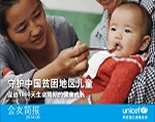-
1/15
UNICEF has been helping the Government of China to develop vaccines, establish cold systems and train health workers since 1979. Now, UNICEF is focusing its immunization projects in Tibet, Inner Mongolia, Guangxi and other minority-populated areas.
http://www.unicef.cn/en/uploadfile/2012/0215/20120215052808561.jpg

-
2/15
The cold chain system is crucial in delivering vaccines safely to remote areas, as vaccines can be easily damaged by temperature changes.
http://www.unicef.cn/en/uploadfile/2012/0215/20120215052544606.jpg

-
3/15
In remote and ethnic areas, more money and technical support is required to deliver vaccines.
http://www.unicef.cn/en/uploadfile/2012/0215/20120215052545453.jpg

-
4/15
UNICEF China EPI Specialist Mr. Zhu Xu wrote in his field trip report in July 2009 that the refrigerator UNICEF provided in the 1980s was still in use in Jiangzi County CDC of Tibet, as the local government was short of the funds to update equipment.
http://www.unicef.cn/en/uploadfile/2012/0215/20120215052545822.jpg

-
5/15
July 2009, Qinghai Province: Village doctor Han Xiuzhen carries a cold box on her way to deliver vaccination services. Often she can find a ride; otherwise, she has to walk. The cold box ensures the safety of vaccines over long distances.
http://www.unicef.cn/en/uploadfile/2012/0215/20120215052546981.jpg

-
6/15
Doctor Hou Wu(L), his father (M) and his colleague in front of a clinic the only vaccination station for nearby villages. Senior Hou, aged 63, said that in his time as the village doctor, vaccines expired easily due to inadequate storage conditions.
http://www.unicef.cn/en/uploadfile/2012/0215/20120215052546362.jpg

-
7/15
UNICEF is working with the Government of China to support areas where the cold chain is not fully functional. The approach includes equipment provision, capacity-building, advocacy, project planning and monitoring.
http://www.unicef.cn/en/uploadfile/2012/0215/20120215052548431.jpg

-
8/15
June 2009, Guangxi Province: Doctor Cao Yue‘an takes vaccines from a cold box to prepare injections for the children in Gaowu Village, Sanjiang Dong Ethnic County.
http://www.unicef.cn/en/uploadfile/2012/0215/20120215052548772.jpg

-
9/15
June 2009, Guangxi Province: Parents wait in a village clinic to get their children vaccinated. Sanjiang County is populated with several ethnic groups and is one of the poorest counties in China.
http://www.unicef.cn/en/uploadfile/2012/0215/20120215052549240.jpg

-
10/15
June 2009, Guangxi Province: A baby receives a vaccine injection in a village clinic.
http://www.unicef.cn/en/uploadfile/2012/0215/20120215052550748.jpg

-
11/15
Zhang Yongjin receives a dose of vaccine at the village clinic. He was delivered at home with the help of his grandmother and received the first dose of Hepatitis B vaccine within 24 hours of birth, thanks to incentives provided by UNICEF and local counterparts.
http://www.unicef.cn/en/uploadfile/2012/0215/20120215052551147.jpg

-
12/15
Doctor Wu Xi administers vaccines. He wants to pursue training to get up to speed with advances in the field of immunization.
http://www.unicef.cn/en/uploadfile/2012/0215/20120215052552432.jpg

-
13/15
Long Yanfang embraces her newly-born son in her grocery shop. Her husband and father-in-law are migrant workers in the city and return home only during Chinese New Year. The one-month-old baby has his own vaccination history certificate.
http://www.unicef.cn/en/uploadfile/2012/0215/20120215052553425.jpg

-
14/15
Children in front of their classroom at Gao Nan Village, Sanjiang County. Primary school teachers are required to check each child‘s vaccination history on the first day of the school year to make sure they haven’t missed any inoculations.
http://www.unicef.cn/en/uploadfile/2012/0215/20120215052554160.jpg

-
15/15
A boy gets a shot in his arm at Jiangzi County, Tibet.
http://www.unicef.cn/en/uploadfile/2012/0215/20120215052555318.jpg









































